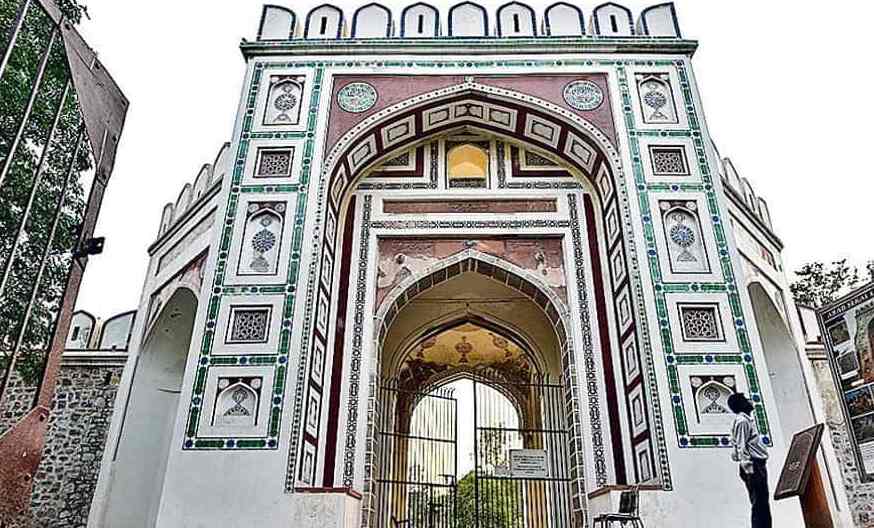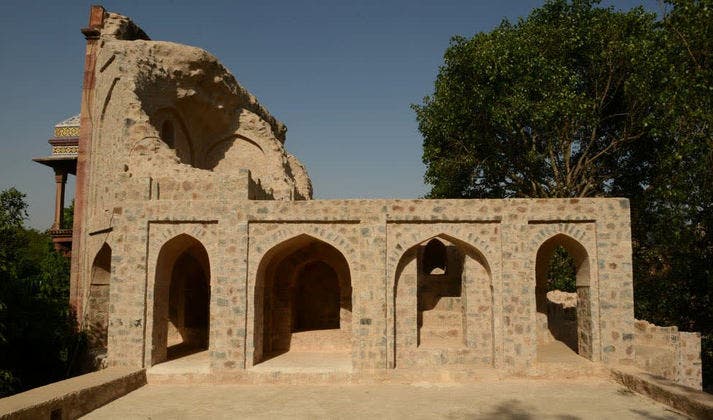History tells us that Arabs went from place to place either for trade or propagation of Islam, or both, or for seeking knowledge. During these travels, they needed more frequent places of rest than the towns and villages could provide.
These ancient desert caravans used to stop at specially built inns called caravanserais (also called khans). Arabs also came to India for trade and they needed such inns on a regular basis.
There are no vestiges of such inns anywhere – except one in New Delhi called Arab Ki Sarai within the premise of Humayun’s Tomb Complex on Mathura Road, which was in a dilapidated state.
The sandstone necropolis of Mughal dynasty, the Humayun’s Tomb built in the 1560s, is one the finest specimen of Indo-Islamic architecture.
Restored to old glory
The Aga Khan Trust for Culture (AKTC), which focuses on the physical, social, cultural and economic revitalization of communities in the developing world, has recently restored this Arab Ki Sarai to its pristine glory.
Just before restoration, the evocative gateway of a walled enclosure built in the 17th century by Hamida Banu Begum was one of few reminders of sturdy, walled roadside caravanserai compound that were in vogue in those bygone days.

Arab Ki Sarai now sports a fresh look having retained the old elements. (Supplied)
The lofty eastern gateway of a walled enclosure built in the 17th century – which was originally a market built during Jahangir’s reign alongside Arab Ki Sarai, Nizamuddin East – now sports a fresh look having retained the old elements.
Arab Ki Sarai has a central arch flanked by projecting balconies that are supported by carved brackets. This 13 meter-high, five-arched gateway, topped with battlements is two-bay deep. It also has chambers and a domed roof flanked by niches on both sides.
The spandrels are ornamented with detailed tile work and medallions bearing Quranic inscriptions. The niches were almost getting dismembered from the main structure and needed repair badly while the area was full of green moss and wild vegetation.
All these now been taken care of by the Aga Khan Trust for Culture (AKTC), which began restoration work in January 2017.
Quranic inscriptions
According to Ujwala Menon, AKTC’s conservation architect, several cracks allowed water penetration resulting in dampness and salt deposits. “Quranic inscriptions got hidden under the layer of cement plaster, tiles were missing and portions of the roof of the gateway had collapsed,” says Memon.
Menon says sadly, not all of the artwork could be restored as evidence had been lost. “As a result, central ceiling medallion had to be left blank. Some of the newspaper articles dating back to 1960s suggest that its walls were adorned with paintings but that could not be restored,” she says.

The Aga Khan Trust for Culture (AKTC) has restored this Arab Ki Sarai to its pristine glory. (Supplied)
We learn from the pages of history that the high gateway that served as the southern entrance of the Arab Ki Serai – built to accommodate the 300 craftsmen whom Hamida Banu Begum, had brought with her on her return from pilgrimage to Mecca now adorn a graceful look after restoration.
These craftsmen were involved in the building of Humayun’s Garden-Tomb. Conservation works included conservation of the main wooden doorway, conservation of the stone façade, reconstruction of the partially collapsed entrance chamber, conservation of the chambers at ground floor.
Pages from history
Author Mirza Sangin Beg, writing in a Persian book Sair-ul-Manazil (Tulika Books) in the 1820s, refers this inn as “property of Arabs and other general populace.”
Author Ranjan Kumar Singh – in his book The Islamic Monuments of Delhi – writes that the Arab Ki Saraiconsists of a large enclosure adjoining the south-west corner of Humayun’s tomb. It is divided by two quadrangles by a series of cells provided with a gateway in the center.
Immediately outside its lofty eastern entrance approached by a gateway from the east, with traces of paintings on its underside, is the second quadrangle, originally bounded by arched cells, which is known as the mandi (market) which was added by Mir Banu Agha.
Courtesy: english.alarabiya.net
Let the Truth be known. If you read VB and like VB, please be a VB Supporter and Help us deliver the Truth to one and all.
New Delhi (PTI): The Congress on Saturday shared diary entries of Vallabhbhai Patel's daughter from a book to rebut Defence Minister Rajnath Singh's claim that India's first prime minister, Jawaharlal Nehru, wanted to build the Babri masjid using public funds, and demanded that Singh apologise for spreading "falsehoods".
Congress general secretary in charge of communications, Jairam Ramesh, claimed the defence minister was spreading falsehoods to “improve his relationship” with Prime Minister Narendra Modi.
“Here is Maniben's original diary entry in Gujarati on pages 212-213 in the book ‘Samarpit Padchhayo Sardarno’ by CA R S Patel 'Aaresh', published by Sardar Patel Vallabhbhai Patel Memorial Society, 2025,” Ramesh said on X, sharing screenshots of the relevant pages from the book.
“There is a huge difference between what is contained in the original diary entry and what Rajnath Singh ji and his fellow ‘distorians’ are propagating,” Ramesh said.
“The Defence Minister must apologise for the falsehoods he is spreading, simply to improve his relationship with the PM,” he claimed.
The Congress had earlier termed Singh's claim that Nehru wanted to build the Babri masjid using public funds a “lie” and “WhatsApp university story”, and said the defence minister should not walk in Prime Minister Narendra Modi's path.
Addressing a gathering at Sadhli village in Gujarat's Vadodara district last Tuesday, Singh said Nehru wanted to build the Babri masjid using public funds, but Sardar Vallabhbhai Patel didn't allow his plans to succeed.
The BJP had cited a book by Vallabhbhai Patel's daughter to double down on Singh's claims, and said the first prime minister also said he felt "repelled" by some of the temples in south India despite their beauty.
“The source of what Rajnath Singh said is the 'Inside Story of Sardar Patel, Diary of Maniben Patel'," BJP Rajya Sabha MP and national spokesperson Sudhanshu Trivedi had said at a press conference at the party headquarters while responding to media queries on the issue.
Trivedi claimed that on Page 24 of the book, it is written that Nehru also raised the question of the Babri mosque, but Sardar Patel made it clear that the government could not spend any money on building a mosque.





